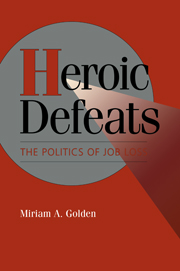Book contents
- Frontmatter
- Contents
- Preface
- List of Abbreviations
- Chapter 1 The Puzzle of Union Responses to Workforce Reductions
- Chapter 2 Games Analyzing Job Loss
- Chapter 3 Job Loss in the Italian and British Automobile Industries
- Chapter 4 Triggers of Industrial Action
- Chapter 5 Pit Closures in the Japanese and British Mining Industries
- Chapter 6 Seeking Allies: How Other Actors Affect Interactions over Job Loss
- Chapter 7 Conclusions
- Notes
- References
- Index
Chapter 4 - Triggers of Industrial Action
Published online by Cambridge University Press: 20 January 2010
- Frontmatter
- Contents
- Preface
- List of Abbreviations
- Chapter 1 The Puzzle of Union Responses to Workforce Reductions
- Chapter 2 Games Analyzing Job Loss
- Chapter 3 Job Loss in the Italian and British Automobile Industries
- Chapter 4 Triggers of Industrial Action
- Chapter 5 Pit Closures in the Japanese and British Mining Industries
- Chapter 6 Seeking Allies: How Other Actors Affect Interactions over Job Loss
- Chapter 7 Conclusions
- Notes
- References
- Index
Summary
When the managers at Fiat and BL launched similar attacks on organized labor at the end of the 1970s, they sought to eliminate surplus labor and to strip shop stewards of the job controls they exercised on the shopfloor. These changes were meant to restore productivity in a context of heightened international competitiveness. Both companies were successful in these aims. Some plants were closed and employees let go; in plants kept open, personnel reductions, often substantial, were achieved using natural wastage, early retirement provisions, voluntary redundancies, and/or temporary layoffs. Between the late 1970s and the early- to mid-1980s both firms reduced their domestic employment levels by one-third to one-half. In neither case were many actually fired.
But the responses of their union movements differed. At Fiat organized labor – from the lowest shop steward to the highest confederal officer – resisted job loss with a long and bitter strike. At BL, conversely, attempts to muster resistance by shop stewards faltered in the face of the determined opposition of national union officials, who ensured labor's acquiescence to job loss and restructuring. Large-scale job loss at British Leyland and at Fiat thus engendered distinctly different responses by organized labor.
The game-theoretic analysis developed in Chapters 1 and 2 suggests explanations for these diverse outcomes.
- Type
- Chapter
- Information
- Heroic DefeatsThe Politics of Job Loss, pp. 66 - 82Publisher: Cambridge University PressPrint publication year: 1996

